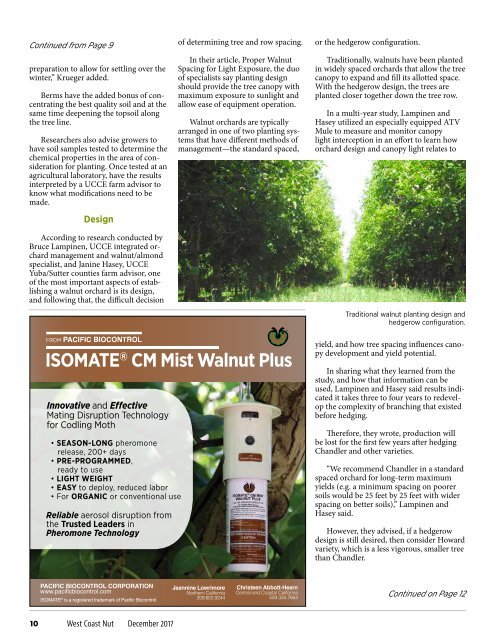WCN_Dec17WEB
Create successful ePaper yourself
Turn your PDF publications into a flip-book with our unique Google optimized e-Paper software.
Continued from Page 9<br />
preparation to allow for settling over the<br />
winter,” Krueger added.<br />
Berms have the added bonus of concentrating<br />
the best quality soil and at the<br />
same time deepening the topsoil along<br />
the tree line.<br />
Researchers also advise growers to<br />
have soil samples tested to determine the<br />
chemical properties in the area of consideration<br />
for planting. Once tested at an<br />
agricultural laboratory, have the results<br />
interpreted by a UCCE farm advisor to<br />
know what modifications need to be<br />
made.<br />
Design<br />
According to research conducted by<br />
Bruce Lampinen, UCCE integrated orchard<br />
management and walnut/almond<br />
specialist, and Janine Hasey, UCCE<br />
Yuba/Sutter counties farm advisor, one<br />
of the most important aspects of establishing<br />
a walnut orchard is its design,<br />
and following that, the difficult decision<br />
of determining tree and row spacing.<br />
In their article, Proper Walnut<br />
Spacing for Light Exposure, the duo<br />
of specialists say planting design<br />
should provide the tree canopy with<br />
maximum exposure to sunlight and<br />
allow ease of equipment operation.<br />
Walnut orchards are typically<br />
arranged in one of two planting systems<br />
that have different methods of<br />
management—the standard spaced,<br />
or the hedgerow configuration.<br />
Traditionally, walnuts have been planted<br />
in widely spaced orchards that allow the tree<br />
canopy to expand and fill its allotted space.<br />
With the hedgerow design, the trees are<br />
planted closer together down the tree row.<br />
In a multi-year study, Lampinen and<br />
Hasey utilized an especially equipped ATV<br />
Mule to measure and monitor canopy<br />
light interception in an effort to learn how<br />
orchard design and canopy light relates to<br />
Traditional walnut planting design and<br />
hedgerow configuration.<br />
ISOMATE ® CM Mist Walnut Plus<br />
Innovative and Effective<br />
Mating Disruption Technology<br />
for Codling Moth<br />
• SEASON-LONG pheromone<br />
release, 200+ days<br />
• PRE-PROGRAMMED,<br />
ready to use<br />
• LIGHT WEIGHT<br />
• EASY to deploy, reduced labor<br />
• For ORGANIC or conventional use<br />
Reliable aerosol disruption from<br />
the Trusted Leaders in<br />
Pheromone Technology<br />
yield, and how tree spacing influences canopy<br />
development and yield potential.<br />
In sharing what they learned from the<br />
study, and how that information can be<br />
used, Lampinen and Hasey said results indicated<br />
it takes three to four years to redevelop<br />
the complexity of branching that existed<br />
before hedging.<br />
Therefore, they wrote, production will<br />
be lost for the first few years after hedging<br />
Chandler and other varieties.<br />
“We recommend Chandler in a standard<br />
spaced orchard for long-term maximum<br />
yields (e.g. a minimum spacing on poorer<br />
soils would be 25 feet by 25 feet with wider<br />
spacing on better soils),” Lampinen and<br />
Hasey said.<br />
However, they advised, if a hedgerow<br />
design is still desired, then consider Howard<br />
variety, which is a less vigorous, smaller tree<br />
than Chandler.<br />
PACIFIC BIOCONTROL CORPORATION<br />
www.pacificbiocontrol.com<br />
ISOMATE ® is a registered trademark of Pacific Biocontrol<br />
Jeannine Lowrimore<br />
Northern California<br />
209.603.9244<br />
Christeen Abbott-Hearn<br />
Central and Coastal California<br />
559.334.7664<br />
Continued on Page 12<br />
10 West Coast Nut December 2017


















